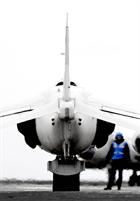SEA HARRIERS MAKE THEIR MARK AT CULDROSE
Aircraft Handlers in the Royal Navy’s Fleet Air Arm are gearing up for the future with a little help from a dear old friend at Royal Naval Air Station Culdrose.
RoyalNavalSeaHarriers, which last saw service in 2010, are still fired-up on a regular basis, training airmen on Culdrose’s concrete “Dummy Deck”. Its successor the F-35 Lightning II won’t fly from HMS Queen Elizabeth until 2018, but the Royal Naval School of Flight Deck Operations (RNSFDO) is maintaining all the skills needed to safely marshal multi-million-pound strike fighters around, launch them and recover to a busy flight deck. Each of the carriers will need a 70-strong flight deck crew to directing operations; four officers, six senior and 60 junior rates.
As well as 108 sailors going through RNSFDO each year at various stages of their handler careers, the Royal Navy also has sailors working with US Navy’s carriers.
The most recent was aboard USS Carl Vinson deployed in theMiddle East, learning the art of working on a ‘big deck’ (the Royal Navy hasn’t had them since the old “HMS Ark Royal” in the late 70s).
“I won’t forget watching night flight ops for the first time,” said Chief Petty Officer Callum Gardner, who has marshalled Hornet and Super Hornet jets , stubby ‘COD’ twin-props delivering passengers and supplies, Hawkeye and Growler intelligence-gathering planes, plus helicopters; more than 70 aircraft in all. “Even after ten years of service, I’ve never seen something so breathtaking. We’ve never had a ship as big as HMS Queen Elizabeth so when we return; we can pass along the info to our flight decks.”
The six Royal Navy senior rates on Carl Vinson all qualified as aircraft directors or aircraft callers had an unforgettable and invaluable experience working a bustling flight deck during live operations. “You feel it in your chest – you don’t feel this anywhere else,” continued Callum.
The mock-up of Culdrose’s Invincible-class carrier flight deck doesn’t offer quite offer the same thrills, a limiter on the Harrier’s engine keeps the 14single and twin-seat aircraft rooted to the Cornish tarmac.
The F35 - Lightening II, is longer, a wider wingspan by 10 ft and twice as heavy as the Harrier, but shepherding and directing working jets does give you all the essential parts of the carrier experience.
The dummy deck has existed in various formats since the late 1950s when Culdrose became the home of handler training. It will require rebuilding again for the Queen Elizabeth’s, whose flight decks are more than twice the size. The school doesn’t need an entire flight deck, but it does need a section recreating at least 140-metre, from the aft island to the stern and 70 metres across. “It’s the width, more than the length, of the new carriers which is likely to catch people out,” said Lieutenant Commander Dave Dougan, formerly flight deck officer on HMS Illustrious and now in charge of the flight deck school. “I probably bore everyone stupid when I bang on about the dummy deck and preparing the way for the F-35s. But it’s quite a transition – new aircraft, new carriers.”
The school uses simulators for some of its instruction to teams on small ships, but for the carrier experience you need a heavy dose of reality. “You still need a jet trundling along for that realistic feeling that you are on a flight deck,” says Lt Cdr Dougan. “Every naval airman comes through the RNSFDO for an experience of moving working jets around, the noise, the weather, and reduced communications are all part of the learning package.”






